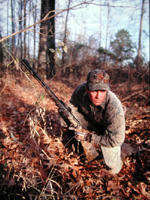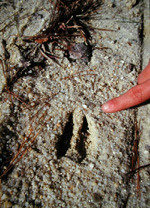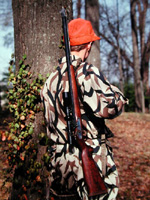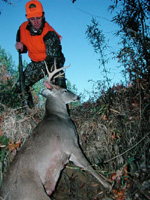
|
Features
|
|
|
|
Books
|
|
|
|
Fun & Games
|
|
|
|
Contact Us
|
|
|
John's Journal... Entry 113, Day 5
LOST IN DEER COUNTRY
Important Survival Information
 EDITOR'S
NOTE: Probably every outdoorsman who has spent hours hunting in unfamiliar
places has at some time in his life been lost in the woods. To enable
you to navigate more effectively and safely through deer country and to
get into these remote locations where big bucks stay, the Night Hawk internet
team interviewed some of the nation's leading woods navigators and survivalists.
EDITOR'S
NOTE: Probably every outdoorsman who has spent hours hunting in unfamiliar
places has at some time in his life been lost in the woods. To enable
you to navigate more effectively and safely through deer country and to
get into these remote locations where big bucks stay, the Night Hawk internet
team interviewed some of the nation's leading woods navigators and survivalists.
John Street, president of Woods Walker, Inc., is a nationally known survival expert whose company made the original space blanket. Patrick McHugh is the general manager of Outdoor Safety Products Division of MPI Outdoor Safety. A woodsman and outdoor safety expert, McHugh and his company have designed products not only to prevent you from getting lost, but also to aid you in the event that you do become lost. Al Kavalauskas is a veteran woodsman, an expert navigator and a well-known outdoorsman. Bill Wildprett is division manager of the Silva Company, which also makes and sells compasses worldwide.
Here's some information you need to know before you go into deer country.
WATER:
1) Water comprises approximately 60% of your total body weight.
* The average person can survive three days without water depending on
the environment.
* Two to four quarts of water are needed each day.
* You lose water through respiration, urination and sweating.
* You need to ration your sweat, NOT your water intake in a survival situation.
* You probably are dehydrated if your urine volume is less than two cups
in 24 hours.
2) Water can be found in a variety of locations.
* Stream, rivers, or lakes.
* Ice or snow.
* Rainfall.
* Plants that catch and store rain.
* Ground.
3) Animals and birds can lead you to water.
4) Unfortunately, in this day and age you need to be aware of chemical pollutants, bacteria, protozoan cysts (giardia), viruses, and parasites.
5) Before boiling, disinfecting, or filtering any water,
use a handkerchief as a screen to filter out any large particles.
* Boiling water will kill all organisms but will not remove chemical pollutants.
Boil water for 10 minutes, plus one minute for every 1,000-feet above
sea level.
* Filtering water (i.e. Katadyn, First Need) with pores smaller than 45
microns removes almost all organisms.
* Chlorine chemicals and iodine chemicals may be used to kill organisms.
Chlorine chemicals may lose potency over a period of time. Iodine chemicals
are contraindicated if you are pregnant, have thyroid problems or an iodine
allergy.
1) The ability to signal rescuers are your link to any
and all available help. Always be prepared to put your signalling efforts
into action.
* Fires -- Build three in a triangle or a straight line.
* Smoke -- Make white smoke with organic, watery fuel or dark smoke with
oil- soaked rags; use what is most visible in your survival environment.
* Aerial flares -- Set off to be seen at great distances.
* Hand-held flares or smoke bombs -- Use s rescuers get closer.
* Light generators and reflectors -- Use flashlights, mirrors, aluminum
foil, bright cloth.
* Noisemakers -- Use whistle, gun, any noise that is not usually present
in the outdoors.
FIRE:
1) Fire can purify water, cook food, signal rescuers, provide warmth and light, and be a friend and a companion. It can be an amazing mood-lifter in a survival situation.
2) Fires should be started away from dead trees, dry
grasses, snow and overhead objects.
* Begin by igniting tinder (a bird's nest of dry bark, dead leaves, frayed
rope, straw, cloth, paper, etc.).
* Add kindling to your tinder (as fire grows), such as small twigs, strips
of wood.
* Make sure the fire receives adequate oxygen as it grows and continue
to add larger fuel, such as non-resinous, dry wood.
3) There are a variety of items you can carry in your
survival kit that will help ignite a fire.
* Matches in a waterproof container or covered with melted paraffin.
* Hurricane or waterproof matches.
* Fire-starter or waterproof matches.
* Magnesium fire starters (works even on damp finder).
* Burning glass (works best on bright, sunny days).
* Bic Lighter.
4) Learning how to light a bow/drill fire and how to make a flint and steel fire is knowledge that may save your life.
1) Make food gathering a priority after you have taken care of your shelter, water and signalling needs, because you can last much longer without food than you can without water.
2) Try to find your protein from fish, mammals, birds
(and heir eggs), reptiles, and insects.
* Fishing - Use the line, hooks and lures from your survival kit or fashion
line from clothing fibers or string, hooks from safety pins, nails, large
thorn needles, wood etc., and lures from shiny materials, feathers, or
foil.
* Trapping/snaring -- Learn how to trap and snare small mammals and birds.
3) Learn how to clean, cook, and preserve these foods.
4) Don't eat anything you cannot positively identify. Unless you are familiar with the local, edible wild plants, you are better off not eating anything unless you're sure what it is.
1) Anything that takes away from or adds to your body temperature of 98.6 degrees is an enemy.
2) The ultimate goal of a shelter is to protect your
body from sun, cold, wind, rain, and snow.
* Layer clothing with wool, polypropylene, and other similar materials,
which are excellent insulators in cold weather.
* Protect your skin from the sun with light colors and choose cotton materials
in the heat.
* Always cover your head.
* Include Emergency Space Blankets in your survival kits to either ward
off sun's rays or to conserve heat.
3) When building an emergency shelter, stay away from mountain ridges (wind, lightning and flash floods); dead trees (falling limbs) and avalanche or rockslide areas (falling snow and rocks).
4) A shelter location must be out of the wind and weather, near water and firewood, and in an area where signals can be built in an open, visible region.
5) Shelters may be built with materials from your survival
kit (emergency space blankets, tube tents, etc.) or from a variety of
natural materials.
* Desert shelter -- Dig a pit in the sand one to two feet deep, use two
space blankets (one tied several inches above the other) tied to four
sticks to create a dead air space between; this will reduce temperature
by up to 40 degrees.
* Forest-bough shelter -- Cut several boughs and angle them out with their
bases all tied to the trunk of a tree weave criss-cross boughs through
angled boughs; make big enough for you, your gear, and firewood.
* Snow-bough shelter -- Bend several boughs from a tree down to the ground,
and pack snow over all the boughs, use space blankets to insulate you
from the ground.
Check back each day this week for more about Lost In Deer Country...
Day 1 - Pre-Trip Planning
Day 2 - What To Do If You Become Lost
Day 3 - How To Find Your Way Out Of The Woods?
Day 4 - Equipment For When You Become Lost
Day 5 - Important Survival Information


